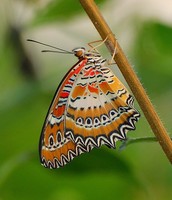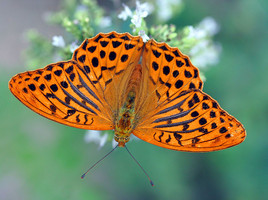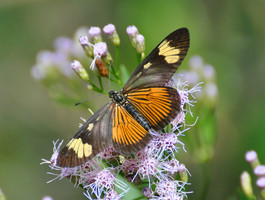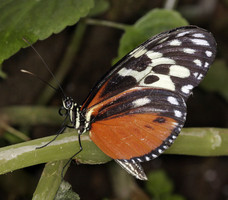Heliconiinae
Niklas Wahlberg and Andrew V. Z. Brower

This tree diagram shows the relationships between several groups of organisms.
The root of the current tree connects the organisms featured in this tree to their containing group and the rest of the Tree of Life. The basal branching point in the tree represents the ancestor of the other groups in the tree. This ancestor diversified over time into several descendent subgroups, which are represented as internal nodes and terminal taxa to the right.

You can click on the root to travel down the Tree of Life all the way to the root of all Life, and you can click on the names of descendent subgroups to travel up the Tree of Life all the way to individual species.
For more information on ToL tree formatting, please see Interpreting the Tree or Classification. To learn more about phylogenetic trees, please visit our Phylogenetic Biology pages.
close boxIntroduction
The subfamily Heliconiinae is composed of a diverse group of species distributed widely in the New and Old World tropics, and it also includes the largely Holarctic fritillaries (Argynnini). Many species in Heliconiini and Acraeini sequester and/or synthesize cyanogenic glucosides, which render them unpalatable to predators. As a result, they act as Müllerian mimics or models for palatable Batesian species in other groups.
References
Brower, A. V. Z. 2000. Phylogenetic relationships among the Nymphalidae (Lepidoptera), inferred from partial sequences of the wingless gene. Proceedings of the Royal Society of London Series B Biological Sciences 267:1201-1211.
Freitas, A. V. L., and K. S. J. Brown. 2004. Phylogeny of the Nymphalidae (Lepidoptera: Papilionoidea). Systematic Biology 53:363-383.
Penz, C., and D. Peggie. 2003. Phylogenetic relationships among Heliconiinae genera based on morphology (Lepidoptera: Nymphalidae). Systematic Entomology 28:451-479.
Silva-Brandão, K. L., Wahlberg, N., Francini, R. B., Azeredo-Espin, A. M. L., Brown, K. S. J., Paluch, M., Lees, D. C. & Freitas, A. V. L. 2008. Phylogenetic relationships of butterflies of the tribe Acraeini (Lepidoptera, Nymphalidae, Heliconiinae) and the evolution of host plant use. Molecular Phylogenetics and Evolution 46, 515-531.
Wahlberg, N., E. Weingartner, and S. Nylin. 2003. Towards a better understanding of the higher systematics of Nymphalidae (Lepidoptera: Papilionoidea). Molecular Phylogenetics and Evolution 28:473-484.
Title Illustrations

| Location | captive |
|---|---|
| Specimen Condition | Live Specimen |
| Source | Cethosia biblis |
| Source Collection | Flickr |
| Image Use |
 This media file is licensed under the Creative Commons Attribution-NonCommercial-ShareAlike License - Version 2.0. This media file is licensed under the Creative Commons Attribution-NonCommercial-ShareAlike License - Version 2.0.
|
| Copyright | © 2008 Luciano Giussani |
| Scientific Name | Argynnis paphia |
|---|---|
| Location | Cévennes, Terre Blanche, France |
| Specimen Condition | Live Specimen |
| Source | Argynnis paphia, Terre Blanche, 2006 |
| Source Collection | Flickr |
| Image Use |
 This media file is licensed under the Creative Commons Attribution-NonCommercial License - Version 2.0. This media file is licensed under the Creative Commons Attribution-NonCommercial License - Version 2.0.
|
| Copyright | © 2006 Pierre Claveirole |
| Scientific Name | Actinote discrepans |
|---|---|
| Location | Rio Grande do Sul, Brazil |
| Comments | Actinote discrepans photographed in Rio Grande do Sul, Brazil, in April 2010. |
| Specimen Condition | Live Specimen |
| Source | Borboleta (Actinote discrepans) |
| Source Collection | Flickr |
| Image Use |
 This media file is licensed under the Creative Commons Attribution-NonCommercial-ShareAlike License - Version 2.0. This media file is licensed under the Creative Commons Attribution-NonCommercial-ShareAlike License - Version 2.0.
|
| Copyright | © 2010 Cláudio Dias Timm |
| Scientific Name | Heliconius hecale |
|---|---|
| Location | Bedford Butterfly Park |
| Specimen Condition | Live Specimen |
| Source | Hacales Longwing |
| Source Collection | Flickr |
| Image Use |
 This media file is licensed under the Creative Commons Attribution-NoDerivs License - Version 2.0. This media file is licensed under the Creative Commons Attribution-NoDerivs License - Version 2.0.
|
| Copyright | © 2006 Bill Hails |
About This Page
Niklas Wahlberg

University of Turku, Finland

Middle Tennessee State University, Murfreesboro, Tennessee, USA
Correspondence regarding this page should be directed to Niklas Wahlberg at and Andrew V. Z. Brower at
Page copyright © 2009 Niklas Wahlberg and
 Page: Tree of Life
Heliconiinae .
Authored by
Niklas Wahlberg and Andrew V. Z. Brower.
The TEXT of this page is licensed under the
Creative Commons Attribution License - Version 3.0. Note that images and other media
featured on this page are each governed by their own license, and they may or may not be available
for reuse. Click on an image or a media link to access the media data window, which provides the
relevant licensing information. For the general terms and conditions of ToL material reuse and
redistribution, please see the Tree of Life Copyright
Policies.
Page: Tree of Life
Heliconiinae .
Authored by
Niklas Wahlberg and Andrew V. Z. Brower.
The TEXT of this page is licensed under the
Creative Commons Attribution License - Version 3.0. Note that images and other media
featured on this page are each governed by their own license, and they may or may not be available
for reuse. Click on an image or a media link to access the media data window, which provides the
relevant licensing information. For the general terms and conditions of ToL material reuse and
redistribution, please see the Tree of Life Copyright
Policies.
- First online 25 September 2006
- Content changed 19 March 2008
Citing this page:
Wahlberg, Niklas and Andrew V. Z. Brower. 2008. Heliconiinae . Version 19 March 2008 (under construction). http://tolweb.org/Heliconiinae/12194/2008.03.19 in The Tree of Life Web Project, http://tolweb.org/













 Go to quick links
Go to quick search
Go to navigation for this section of the ToL site
Go to detailed links for the ToL site
Go to quick links
Go to quick search
Go to navigation for this section of the ToL site
Go to detailed links for the ToL site